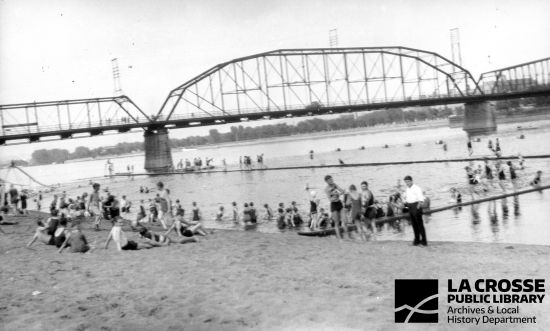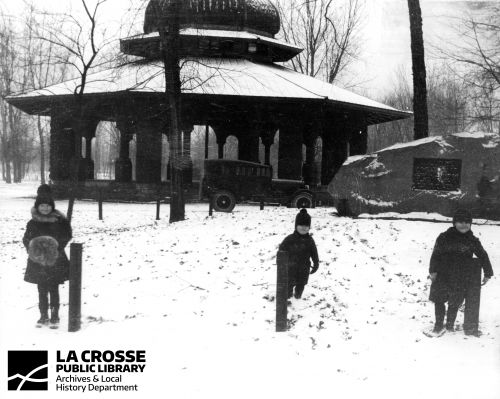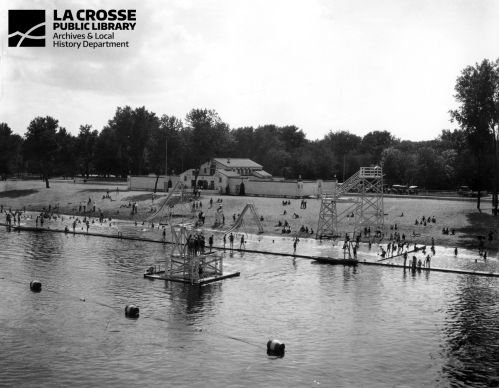
Pettibone Park
(written by Samuel Ott, Archives intern)
It is nearly impossible to measure the impact that Albert W. Pettibone and his wife Cordelia have had upon the city of La Crosse. They privately funded, built, maintained and then gifted La Crosse its first large park. Ever since the Pettibone’s generous gift was given to the city in 1901, Pettibone Park has been buzzing with people eagerly enjoying the many activities that the park provides access to.

Photo of Pettibone Beach filled with kids swimming, ca. 1930s. Note the old swing bridge in the background, which would collapse a couple of years after this picture was taken.
Pettibone, a long time La Crosse resident, desired to create a permanent memorial to his deceased children and thought something that would create joy for many people was the best way to do that. In 1900, he began to acquire all the land on what was then known as Barron Island with the goal of turning the island into a beautiful park for the city.
Other than the sole person who lived on the island, people rarely travelled to it. Most people viewed it as a useless swamp. One La Crosse Tribune article stated that the island was “a low, marshy, unsightly tract of land covered with vines and underbrush and whose only redeeming feature was its location and wealth of beautiful trees.” However, Pettibone saw value in the island and pressed ahead with the development of his project.

An early aerial photograph of Pettibone Island after the park improvements were completed.
Pettibone was determined to make sure that the park would be a spectacular one, and contributed large amounts of his personal fortune to turn it into something that the city would treasure. He knew that the island while appearing unsightly at first, could be turned into something great with a little work. Sure enough, it was not difficult to make Pettibone’s vision a reality. Lakes were dredged and beaches were created with relative ease. Some heavy foliage was cleared to make way for a beautiful campground.
There were a variety of other improvements, including the construction of a stone pavilion, a bath house, a park shelter, roads and pathways. Frank Nutter, a local landscape architect and engineer, was brought in to help professionally plan the improvements. Nutter was a central reason for these improvements being carried out in the most effective and beneficial manner. Nutter’s plan also ensured that the park had a degree of flood protection (though it would later prove inadequate) and that the park would be able to be used year round.

Photo of children playing near the pavilion in Pettibone Park, ca. 1930s.
After Pettibone finished the series of improvements to Barron Island, he deeded the land to the City of La Crosse for a single dollar. However, there was a small problem. Part of Barron Island was in Minnesota. Legislation was immediately drawn up to figure out how to annex the island. Several proposals were drawn up trading various islands that Minnesota coveted for the island which hosted La Crosse’s newest park. The final proposal traded Barron Island for a Wisconsin owned island near Winona, where there was desire to turn that piece of land into a park for the people of Winona. The deal went through. In 1919, the island was officially annexed by the City of La Crosse.

Early photo of the bath house and water attractions in the newly completed Pettibone Park.
Having the foresight to realize that the park would be in need of routine maintenance, Pettibone gifted the city $50,000 for the future upkeep of the park. That combined with the initial improvements totaled $115,000 of private funds that the Pettibones spent on the park. This is equivalent to over 3 million dollars today. The park was originally set up by Pettibone to be run separately from the newly established Parks Commission, and operated using the money that he had set aside for it.
The park continued to function independently as Pettibone intended, without additional funds from the city until 1969. In 1969, the combination of depleted funds and significant flood damage meant that Pettibone Park could no longer continue to operate on its own. The City of La Crosse stepped in and in a unanimous vote, the Common Council Finance Committee, voted to provide all necessary funding for repairs and to integrate the park in the greater park system.
To learn more about the history of parks in La Crosse, contact the La Crosse Public Library Archives and Local History Department at (608) 789-7136 or archives@lacrosselibrary.org. Also, join us on Historic Downtown Day for the Voices of La Crosse history tours, one of which is about the history of La Crosse’s parks.

